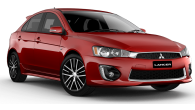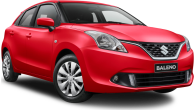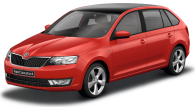For the new-generation Ford Fiesta 2019 range, only one version will be offered - the all-new Ford Fiesta ST.
Ford Australia has taken the bold move of pulling out of the light car segment with the exception of this manic little hot hatch.
It has big shoes to fill, following on from what was widely acclaimed as the benchmark when it came to budget pocket rocket performance and outright driver enjoyment.
And, like the previous model, the new 2019 Ford Fiesta ST follows the fun-for-your-money formula to a tee: front-drive, manual, turbocharged... but this time around, things are very different - inside, outside, and under the skin.
.jpg)
Ford Fiesta 2019: ST (5 YR)
| Engine Type | Turbo 4, 1.6L |
|---|---|
| Fuel Type | Unleaded Petrol |
| Fuel Efficiency | 6.2L/100km (combined) |
| Seating | 5 |
| Price From | $15,950 - $20,460 |
| Safety Rating |
|
Does it represent good value for the price? What features does it come with?
8 / 10
We don't know what it will cost just yet, but strong indications from Ford Australia suggest a price tag of less than $30,000. It'll need to be there, given it is manual only.
Ford Australia has indicated it knows where the competitors sit - the new-generation Volkswagen Polo GTI is the main one, and that car will be automatic only (dual-clutch), and come in five-door guise, priced at $30,990.
Like its German rival, the Ford hot hatch will come comprehensively equipped for the money. There's an array of safety gear (see below) fitted as standard, plus a bunch of nice interior and exterior highlights.
Things like push-button start, keyless entry, leather-trimmed steering wheel and gear knob, Recaro sports seats with sporty cloth trim, auto headlights and wipers, cruise control, single-zone climate control and possibly heating seats and a heated steering wheel.
It's expected there will be 18-inch wheels fitted as standard (take that, 17-inch clad Polo GTI!), but it appears unlikely Aussie buyers will get the option of a dual-pane glass roof that is being offered in some markets.
The real determinant for a lot of buyers could be whether the company decides to offer three- and five-door models, though. As a one-time fancier of the existing Fiesta ST who ruled it out as a potential purchase out because it was a three-door, I know I speak for a lot of would-be Ford customers in saying that a five-door would be very, very enticing.
.jpg)
Is there anything interesting about its design?
9 / 10
It's less nosey than before - there's no doubt about that. The new Fiesta looks much better proportioned than its precursor, with an upright grille, sweeping lines through the body, and a "perfect" proportion between the metal and glass… according to the chief designer of the car. For what it's worth, I tend to agree - both in three- and five-door guise, this thing is a looker.
At the rear the tail-lights are now horizontal, rather than vertical, and that helps broaden the car visually, hunkering it down to the road. And in actual fact, the new-generation Fiesta ST is bigger in all the important directions than its predecessor: it is now 4068mm long (+93mm), 1735mm wide (+26mm) and the wheelbase is longer, too, now at 2493mm (+4mm). It's lower to the ground, as well: now 1469mm (-26mm).
Those dimensions are identical between three- and five-door models, and you can make your own mind up about which you prefer. But to me, there's a clear distinction between them: the three-door could be considered a bit of a selfish option - a car that's designed for the driver primarily, and that's undoubtedly a worthy attribute for a pint-size hot hatch; the five-door version is a more sensible option - it doesn't suffer enormous doors, and the packaging and practicality is pretty good for a little hatchback.
No matter the number of doors, the Fiesta ST gets clever door-ding protecting flip out barriers, the same as you see on a Skoda Kodiaq. It's a very nice piece of thoughtful design, especially for the three-door, because the doors themselves are massive for the size of the car.
The ST rolls on either 17- or 18-inch wheels, and it's unclear what we'll get (our money is on 18s). And it's still unclear if we'll get the three-door, the five-door, or maybe both. One would think that if Ford Australia was clever, it would try and maximise the options for buyers, because it's already excluding 90 per cent of the market by not offering an automatic transmission.
.jpg)
How practical is the space inside?
7 / 10
If there was a criticism that could be levelled at the old ST, it was that the interior felt like it hadn't moved on from its 2013 roots. The new one? Well, it's definitely up to date, even if it is also clearly based on an affordable hatchback and therefore has a few of less than luscious plastics.
There's the now typical tablet style media screen front and centre on the dashboard, an 8.0-inch touch-capacitive unit with the latest Ford Sync 3 interface, in-built sat nav, a crisp reversing camera display with active steering guidelines, and Apple CarPlay/Android Auto smartphone mirroring technology. It works well, and looks a helluva lot better than the existing car's 4.2-inch TFT with Sync 1.1.
The seats in the test vehicles were Recaro buckets, which may be a little tight at the base for broader-hipped individuals (yours truly included), but they offer terrific support and bracing in corners thanks to the huge body-hugging bolsters.
The seats also feature plenty of adjustment, including manual height adjust for the base, and tilt adjust as well.
.jpg)
Of course there are the usual storage bits and bobs up front - a pair of cupholders between the front seats (with illumination), a smallish centre console bin, and a pair of slim door pockets.
The back seat of the three-door and five-door models is suitable for getting you and your friends or children from one place to another, but it wouldn't be an enjoyable long-distance road trip car. And if you happen to go through some corners, you'll struggle to find anything to hang on to in the back (in a three-door, in particular) as there are no roof grab handles at all (three- or five-door).
The back seat does have ISOFIX and child-seat anchor points, but it misses out on some basic inclusions: there is no fold-down centre armrest, no rear cupholders, and only a couple of small storage areas - whether the model you're in has five doors or three. There are no rear air vents, either, but it's a pretty small car.
The boot is a good size for this class, too, with 311 litres of cargo capacity - easily enough for a couple of weekend bags. There's a space-saver spare wheel under the floor - unless you get a car with the Bang & Olufsen stereo system, which uses that area for a subwoofer and instead includes a "tyre management kit".
.jpg)
What are the key stats for the engine and transmission?
9 / 10
The 1.5-litre three-cylinder turbocharged petrol engine matches the power output of the existing model (well, the old model on overboost, anyway), with 147kW at 6000rpm. That's pretty amazing horsepower from a triple.
The torque figure needn't be sneezed at, either with 290Nm from 1600-4000rpm. That's 50Nm more than the old car (or 20Nm more if you're talking the overboost numbers), across a slightly narrower rev range. But the tractability of the engine is superb. Read the driving section below for more on that.
Oh, and you might want to know the 0-100km/h time, too? It's 6.5 seconds, which is 0.4sec quicker than the claimed 0-100 time of the existing car, and that's despite the fact it's quite a bit heavier than the existing model: three-door for three-door, the weight is up 90kg (now 1262kg), and the five-door is 21kg. Top speed is claimed at 232km/h.
.jpg)
How much fuel does it consume?
7 / 10
The new Fiesta ST is claimed to use 6.0 litres per 100 kilometres, which is high for a three-cylinder engine… well, if it were an economy-tuned three-cylinder. But it's still pretty good for a hot hatch.
And the 1.5-litre is the first three-cylinder from Ford to offer a cylinder deactivation system, which can make the engine run on two cylinders only under low loads. You can hear it and feel it when that happens, but it's apparently good to help you save about 6 per cent on fuel consumption when it does.
Over a very - shall we say - spirited drive in the mountains behind Nice in France, I saw just over 10 litres per hundred indicated on the dashboard.
.jpg)
Warranty & Safety Rating
What safety equipment is fitted? What safety rating?
8 / 10
The new Ford Fiesta ST hasn't been crash-tested anywhere in the world, but the regular model has, and it scored the maximum five-star rating under the Euro NCAP regime. It isn't clear if the ST will cop the same score or not just yet.
The standard safety kit list in the Fiesta ST is extensive.
Along with six airbags (dual front, front side, full-length curtain - no driver's knee like the existing Fiesta) there is a reversing camera, rear parking sensors, auto emergency braking (AEB), lane departure warning, lane-keeping assist, blind-spot monitoring, auto high-beam lights, traffic sign recognition, hill-hold assist and driver fatigue alert.
What does it cost to own? What warranty is offered?
8 / 10
It's a much more promising ownership program than it once was, with Ford having recently introduced a five-year/unlimited kilometre warranty across all of its models (purchased from May 1, 2018). Previously the brand backed its cars with a three-year/100,000km plan.
There will be capped-price servicing under Ford's 'Service Price Promise' plan, which will span the life of the car, as it does with all Ford models. The previous plan required servicing every 12 months/15,000km and it is expected that will be the same for the new model.
Ford will also update the Sync 3 sat nav maps for seven years from the date of purchase if you maintain your car with them throughout.
What's it like to drive?
9 / 10
I love the character and sound of three-cylinder cars - I own two of them, a Mini Cooper and a Volkswagen up! - and anyone who may have thought that the charm of the Fiesta ST could be damaged by the swap from four to three cylinders, you needn't fear. It's more loveable than ever.
The way the engine sears with power and punches its torque out is phenomenal, a true testament to Ford's engineers that have made something thoroughly entertaining with the 2019 Fiesta ST.
Of course it still has a six-speed manual - it's a Euro hot hatch, after all - but still no automatic, dual-clutch or otherwise. It's a good little gearbox, with decent shift feel and a light but usable clutch. The throw is a little long, and first gear is pretty short, but it's easy enough to pedal through the gears.
There is a launch control system that'll hold revs for you, allowing you to dump the clutch and take off very speedily. And if you're worried about just how quick you're going, there's a digital speedometer in the middle of the manual gauge cluster. It's a shame the new Fiesta doesn't get the same 12.0-inch digital driver display that the Mustang has - it would have lifted the interior ambience even more.
It also lacks a rev matching system - aaaaaand you get that sporty tech in the a new-generation base model manual Corolla.
The traction on offer is immense - as you may expect, the vehicle we tested with the Quaife limited-slip differential clambered out of tight corners tremendously, where the car with the open diff was more of a handful in the twisty stuff.
.jpg)
There's also a torque vectoring (by braking) system, which will grab the brake of the inside front wheel to enhance the turn response, and if you want to, you can provoke the back end to step around on itself to a degree - if you opt for the Sport ESC setting and Sport drive mode and find a series of hairpins, the Fiesta ST will cock its back leg more than an eager dog on a morning walk.
We didn't sample Race Mode, because we weren't at a race track. Safety first… and as it was, we had to dodge public holiday cyclists by the hundred, and speeding Renault Kangoo drivers that seemed to have forgotten what side of the road they were supposed to be on.
There is no Individual or Custom mode, so you can't pick and choose settings you might want to.
There is some torque-steer to contend with, but rather than being annoying, it's actually pretty endearing - and the ultra-quick steering (a 12:1 ratio electric steering set-up, the quickest ever from Ford) makes you feel more dialled-in to the drive experience.
While some of my fellow Aussie journos had questions over a slight fuzziness to the steering on-centre, I had no such complaints with the way this car tipped into a tight bend or changed direction part way through.
Another dialled-in element is the suspension - the front end is a MacPherson strut set-up with twin-tube dampers and a thick (22.5mm) anti-roll bar, the rear a torsion beam arrangement that is stiffer than anything else to have come from Ford Performance.
The most surprising bit is how nicely the Fiesta ST rides. It is undeniably more comfortable than the existing model (I got a lift in one just two days before the launch drive), and while our test loop wasn't the typical rat-run through the back streets of Sydney or Melbourne, it promises to be well sorted when it comes to bump and body control.
Verdict
The new-generation Ford Fiesta ST is instantly more appealing than its predecessor - it is smarter inside, more efficient and more powerful, more enjoyable and better to look at. There is no denying it will appeal to more people, even if it does miss out on the crucial automatic transmission that so many buyers want.
I just really hope Ford helps it along by making the five-door model available to local buyers, because it would be the best move - for the brand, and its potential customers.
.jpg)
.jpg)
.jpg)
.jpg)






































.jpg)
.jpg)
.jpg)

.jpg)